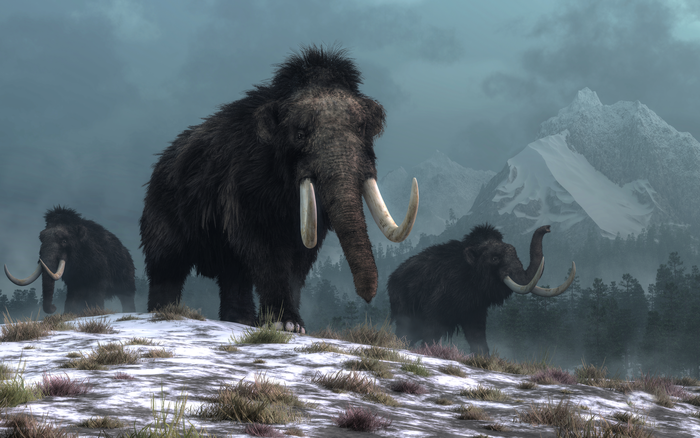An international group of scientists from the USA, the UK, Canada, Denmark, Germany, France, Norway, Sweden, China and Russia including researchers from
St Petersburg University have found that an abrupt climate change caused the extinction of mammoths in Siberia 12,000 years ago. The findings are published in the scientific journal Nature.
Scientists performed a metagenomics analysis of ancient environmental DNA (eDNA) of plants and animals recovered from sediments at the sites distributed across much of the Arctic covering the past 50,000 years. Multiple remains enabled the scientists not only to learn more about the representatives of the ancient megafauna, but also find the reasons of their extinction.
The woolly mammoth is an extinct species of the ancient ancestors of elephants that appeared about 450 years ago in the territory of modern Siberia and became globally extinct about 4 thousand years ago. The meat of mammals was used as food for early humans, while the skeleton and tusks were utilised in the construction of houses and weapons. For a long time, it was considered that human hunting caused the extinction of mammoths. However, scientists determined that the main reason was an abrupt climate change.
The research showed that the animals became extinct due to the lack of food caused by melting ices of the Arctic. Eske Willerslev, Professor of St. John's College at the University of Cambridge, Director of University of Copenhagen’s Centre of Excellence GeoGenetics explained that the reason of the mammal extinction was a dramatic climate change. Ice melt in the Arctic caused increased humidity, formation of lakes, rivers and swamps and almost complete extinction of vegetation that served as food to mammoths. Large animals were unable to adapt promptly to the scarce ratio after the prominent landscape change. Moreover, trees and swamp plants occupied the mammoth grazing areas after the warming.
‘The ecosystem changed and the reduced plant biomass could not feed herds of mammoths anymore. We demonstrated that the climate change and, particularly, precipitation directly affects the vegetation, while people had no impact whatsoever,’ explained Yucheng Wang, researcher of the Department of Zoology at the University of Cambridge.
A group of scientists at St Petersburg University works on reconstructing the development of climate and environment based on the study of lakes and lake sediments. The researchers at St Petersburg University presented samples of quaternary sediments obtained during the excavation at Severnaya Zemlya Archipelago and Taimyr Peninsula. These data have contributed to the collection of materials from 535 locations in the Arctic.
The findings based on the international scientific research demonstrated that the woolly mammoth and its ancestors inhabited all continents apart from Australia and South America. Previously, it was considered that the population survived the end of the last ice age in small areas along the coastline of Siberia and Alaska in Wrangel Island and St. Paul Island. However, recent research has shown that they actually lived for longer periods of time in other areas. Notably, the breeds of mammoths in both islands were closely related despite their geographical segregation.
‘Modern methods allow the scientists to determine DNA traces of various animals and plants, for instance, in lake sediments and along the hydrographic water basins previously inhabited by these organisms. This is a powerful tool to reconstruct the habitat of distinct species, the character of vegetation, the composition of fauna in specific regions and, ultimately, the development of climate and the environment as a whole,’ said Grigory Fedorov, Associate Professor at the Department of Geomorphology, St Petersburg University.
A large number of collected DNA samples allowed for the scientists to create a map of the mammal distribution as well as demonstrate the dynamics of the population extinction. The experts managed to prove that after the last glacier period (the Late Pleistocene that completed 12,000 years ago) the mammoth habitat significantly reduced, however, they survived in various regions of the Arctic and lived much longer than previously presumed. Thus, according to the recent data, woolly mammoths lived up to the Holocene – a modern geological epoch of the Quaternary period that followed the Pleistocene about 12,000 years ago.
